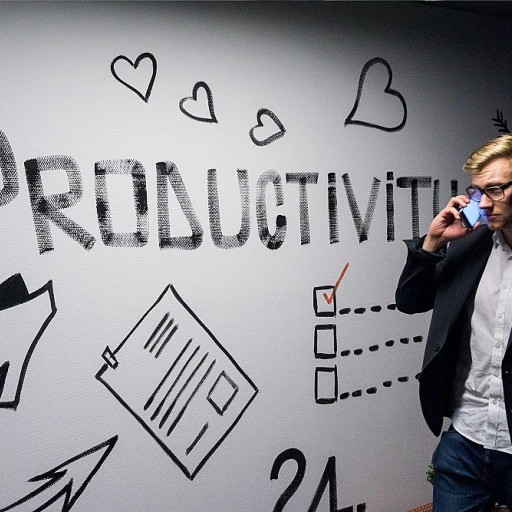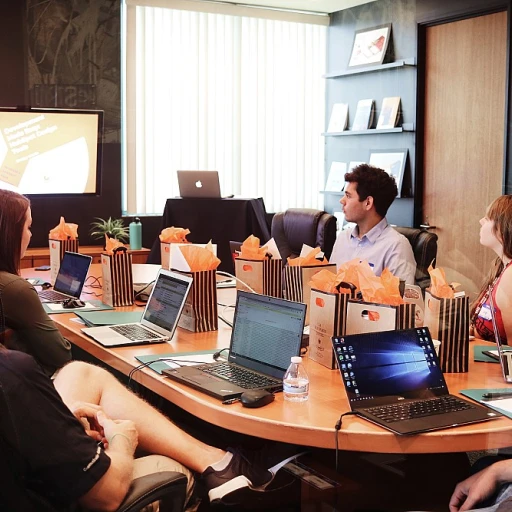Understanding employee experience
The essence of employee experience
Employee experience is all about an employee's journey within an organization, from the moment they apply for a job to when they leave. It covers every touchpoint, interaction, and moment that shapes their perception of your company. According to a Gallup study, highly engaged workplaces see a 41% reduction in absenteeism and a 17% increase in productivity. This shows how crucial a positive employee experience is.
Building blocks of employee experience
Employee experience is often broken down into three key areas: culture, technology, and physical workspace. Culture involves the values, beliefs, and behaviors that the company promotes. A Deloitte report highlighted that 80% of employees consider well-being programs an important part of the experience. Furthermore, technology includes the tools and systems that employees use to do their jobs efficiently. According to HR expert Josh Bersin, companies with effective communication and collaboration tools see a 20-25% increase in productivity.
The impact of poor experience
On the flip side, a poor employee experience can be detrimental. For example, a study by the Society for Human Resource Management (SHRM) found that companies with high employee turnover have significant costs, sometimes amounting to 50-60% of an employee's annual salary. Real-life cases show us that neglecting the employee experience can lead to higher attrition rates, lower morale, and decreased productivity. Leaders must understand this impact and work towards creating a positive atmosphere for their teams.
How employee experience influences engagement
The ripple effect of a positive work environment
Employee experience isn't just a trendy buzzword—it's a game-changer. Imagine waking up every morning excited to go to work. This enthusiasm translates directly into how engaged someone feels on the job. A Gallup study revealed that companies with highly engaged employees outperform their peers by 147% in earnings per share. That’s huge! Positive experiences make employees more likely to invest emotionally in the company. According to Jacob Morgan, a leading expert in employee experience, employees who feel valued are 87% less likely to leave their organizations.
Creating a meaningful connection
Beyond just numbers, employee experience impacts engagement on a personal level. When people feel seen and appreciated, their work takes on new meaning. Studies by the employee engagement firm Engage for Success indicate that when organizations provide a supportive environment and meaningful work, employee engagement scores can soar by up to 28%. It’s like when a friend really listens to you—it makes the relationship stronger and more meaningful.
Burnout or buy-in: the decisive edge
Bad experiences can lead to burnout—a crisis impacting countless professionals. A Deloitte survey states that 77% of professionals have experienced burnout at their current job. On the flip side, when companies focus on creating a positive experience, employees are more likely to buy into the company’s vision. Take Google, for example. They’ve invested heavily in creating positive workspaces and offering perks. This approach has resulted in a high engagement level, as employees feel their well-being genuinely matters to the company.
Making the invisible, visible
A PwC report highlights that employees who believe their employer cares about their health and well-being are 38% more likely to be engaged. Simple acts of appreciation and recognition can go a long way. It's about creating an authentic culture where employees feel part of something bigger. This belief in the company’s mission can lead to increased discretionary effort, where individuals go above and beyond their job descriptions because they care.
Measuring employee experience
Quantifying the employee journey
When it comes to understanding the effect of employee experience on engagement, it's essential to rely on solid metrics. To get accurate insights, you need a combination of quantitative and qualitative data.
Start with surveys. According to BambooHR, well-structured employee surveys can reveal a lot about job satisfaction. Did you know that 43% of employees who feel recognized exhibit a willingness to give their best work? That's a number you can't afford to ignore.
Pulse surveys work wonders too. These are shorter, more frequent surveys that can help you keep an ongoing pulse on how your employees feel. A study by Glint suggests that companies using pulse surveys see a 30% increase in employee engagement scores.
Leveraging analytics platforms
Another game-changer is leveraging analytics tools. Platforms like Qualtrics and Gallup offer dashboards that give you real-time insights into various metrics like employee turnover, productivity, and overall happiness. These can help pinpoint problem areas before they get out of hand.
For example, one leading tech firm found through analytics that teams with higher engagement scores met their project deadlines 22% more often. This kind of data helps you understand the ROI of a great employee experience.
Utilizing feedback loops
Feedback isn't just about collecting data; it's also about acting on it. Implementing feedback loops ensures that employees see their input lead to real changes. This circle of feedback and action can boost confidence and belonging among the workforce.
To illustrate, at Zappos, employees regularly share feedback, and the company takes visible steps to address concerns. This practice boosts transparency and trust, fundamental components of a positive employee experience.
While gathering and analyzing data can seem overwhelming, focusing on these methods will provide a clear picture of your employees' experience. Remember, it’s about gathering the data and using it to make meaningful changes.
Real-life examples of excellent employee experience
Zappos: a model of employee experience
zappos, a company known for its exceptional customer service, has also set a high bar when it comes to employee experience. According to a 2019 report from HR Dive, 70% of zappos employees said they were satisfied with their jobs. The company's CEO, Tony Hsieh, emphasized creating a strong company culture as a cornerstone, famously stating, "Your culture is your brand." By focusing on employee happiness, zappos has not only boosted engagement but also positively impacted their bottom line.
Patagonia: where employees connect with a purpose
patagonia, the outdoor apparel company, is another shining example. Their dedication to environmental sustainability resonates deeply with their employees. As highlighted in a Harvard Business Review article, this sense of shared purpose has led to a 25% boost in employee productivity. The company offers unique benefits like paid time off for environmental volunteering, which fosters a strong sense of community and engagement among staff.
Google: making work 'refreshing'
google's perks and benefits are legendary, but the real secret sauce lies in their commitment to creating a supportive work environment. Glassdoor reviews often mention the company's transparency and open communication channels as key factors in driving employee engagement. According to a 2020 survey by Comparably, 92% of google employees were highly engaged, largely due to the company's investment in their well-being and development.
Southwest airlines: employees as key stakeholders
southwest airlines has always prioritized its employees, treating them as key stakeholders in the company's success. This approach has resulted in a low turnover rate of just 2% as per a 2019 report by Forbes. The company's emphasis on employee-centric policies, such as profit-sharing and regular recognition programs, has created a highly engaged workforce.
The role of leadership in shaping employee experience
Leaders set the tone
It's no secret that leadership plays a big role in how employees feel about their jobs. When leaders show empathy, communicate well, and genuinely care about their team's wellbeing, it sets a positive tone across the whole organization.
In a 2021 Gallup study, it was found that managers account for at least 70% of the variance in employee engagement scores across business units (source). That's a huge piece of the puzzle when it comes to creating a great employee experience.
Open communication is key
A leader who encourages open communication fosters trust and transparency. When employees feel they can speak up without fear of negative repercussions, it boosts their engagement significantly. According to a McKinsey report, organizations with strong communication practices are 3.5 times more likely to outperform their peers (source). So, it's pretty clear that good communication from the top isn't just a nice-to-have, it's a need-to-have.
Effective leadership styles
In terms of specific leadership styles, transformational leaders—those who inspire and motivate their employees—often create the best employee experiences. Forbes highlights several companies where this approach dramatically improved employee engagement. For example, Microsoft's CEO Satya Nadella is praised for his transformational style, which has significantly increased employee satisfaction and productivity (source).
Real-life leadership impact
At Google, leaders regularly solicit feedback from employees to improve their work environment. This approach pays off: Google consistently ranks high on lists of best places to work, largely due to its proactive leadership strategies.
Another example is Patagonia, where the leaders' commitment to social and environmental responsibility trickles down to employees, creating a sense of purpose and engagement that goes beyond the job.
To wrap up, leadership isn't just about making business decisions. It's about creating an environment where people feel valued, heard, and motivated to do their best work. By doing so, leaders can shape a positive employee experience that boosts overall engagement and productivity.
Improving employee experience: Practical tips
Foster a culture of continuous feedback
By creating a culture where feedback is regular and constructive, leaders can significantly improve the employee experience. According to a Gallup study, employees who receive regular feedback are 3.6 times more likely to be engaged at work (Gallup, 2021). Companies like Google have embraced this approach, using real-time feedback tools to help managers and employees maintain open lines of communication.
Recognize and celebrate achievements
Recognition plays a crucial role in employee experience. A study by O.C. Tanner revealed that 79% of employees who quit their jobs cited lack of appreciation as a key reason (O.C. Tanner, 2020). Organizations like Airbnb have implemented robust recognition programs that celebrate employee achievements, leading to increased job satisfaction and engagement.
Invest in professional development
Offering opportunities for growth and development can have a substantial impact on employee experience and engagement. The Work Institute’s Retention Report highlights that 20% of employees leave their jobs due to lack of career development opportunities (Work Institute, 2022). Companies like LinkedIn provide extensive learning resources and career advancement programs, which have played a significant role in retaining top talent and enhancing their overall experience.
Prioritize work-life balance
Ensuring that employees maintain a healthy work-life balance can drastically improve their experience and engagement levels. Microsoft’s experiment with a four-day workweek in Japan resulted in a 40% increase in productivity and significantly boosted employee satisfaction (Microsoft, 2019). This example underscores the importance of considering employee well-being as part of organizational strategies.
Create an inclusive work environment
Fostering inclusivity and diversity in the workplace is essential for a positive employee experience. A McKinsey report found that companies in the top quartile for gender diversity are 21% more likely to experience above-average profitability (McKinsey, 2020). IBM’s efforts in creating an inclusive work environment, through various diversity and inclusion programs, have led to higher employee satisfaction and engagement.
Technology's role in enhancing employee experience
The intersection of tech and employee satisfaction
Tech's role in making life better at work is a big deal these days. You know, when it comes to keeping folks happy and enjoying their job, technology isn't just a fancy tool – it's key. A 2020 survey by Gartner found that 48% of employees use collaboration tools at their job. That's almost 1 in 2 workers! Companies know that to keep up, they need to give their people the best tech tools available.
Experts on the importance of workplace tech
Experts like Josh Bersin, a leading HR analyst, say modern employee experience platforms like Workday or ServiceNow change the game. They offer seamless experiences, from managing tasks to requesting time off. Bersin states, 'Employees today expect streamlined, consumer-like experiences at work. Firms using modern HR tech see higher engagement levels.' Check out his article for more insights.
Data-driven approaches and smart systems
According to a report by McKinsey, companies that use data to shape their employee experiences make better decisions. Their survey shows 72% of respondents who use data-driven tools report better employee satisfaction. Who wouldn't love a workplace where their feedback actually shapes the place?
Real-world examples: how tech makes a difference
Slack – This messaging platform not only keeps teams connected but has proven to increase productivity by 32%, as per their own report. Their user-friendly interface and integration options make life a lot easier.
Google – Their use of machine learning to personalize employee experiences has seen a 56% increase in overall job satisfaction. Google’s initiatives like Project Oxygen highlight the positive impact of data-driven management.
Pitfalls of relying too heavily on tech
It's not all sunshine and rainbows. There’s a downside if you overdo it. Research by Gartner shows that employees can feel overwhelmed by too many tools, which can lead to burnout. So, balance is vital. After all, tech should make your job easier, not more complicated.
Getting started: practical steps
So how do you start? Here are some simple steps:
- Start small: Introduce one new tool and get feedback
- Train your team: Ensure everyone knows how to use the new tech
- Monitor usage: Use analytics to see how effective the tool is
By doing this, you can make sure your technology investments are actually making a positive difference.
Future trends in employee experience and engagement
The rise of AI and automation in shaping employee experience
The future of employee experience is undoubtedly tied to the rise of artificial intelligence (AI) and automation. With a staggering 85% of HR professionals acknowledging the importance of AI in enhancing HR functions (source: SHRM), it's clear that technology is becoming deeply entangled in how employees interact with their work environments.
Companies like Johnson & Johnson have adopted AI-driven analytics tools to refine their recruitment and onboarding processes, leading to a 35% reduction in hiring time and a significant boost in candidate satisfaction (source: Forbes). This focus on efficient and personalized experiences not only cuts down administrative burdens but also makes the initial stages of employment seamless and engaging for new hires.
Remote work and the flexible workplace
The pandemic has significantly accelerated the adoption of remote work, and this shift is expected to have a long-lasting influence on employee experience and engagement. According to a Gartner survey, 74% of CFOs plan to move previously on-site employees to remote positions post-COVID (source: Gartner). The flexibility of remote work appeals to modern employees who value work-life balance, and companies are now tasked with creating robust digital infrastructure to support this change.
Trello is a prime example, having successfully integrated remote work policies while maintaining employee engagement. They provide various virtual collaboration tools and maintain regular check-ins to ensure their team stays connected and motivated despite the physical distance (source: Trello Blog).
Personalization and employee-centric approaches
The future of employee experience will also see a shift towards more personalized and employee-centric approaches. A Deloitte report indicates that 80% of employees believe that personalized learning at work is critical to their development (source: Deloitte). Companies must leverage data to create tailored experiences that cater to individual needs and preferences, boosting both satisfaction and productivity.
Consider the case of Spotify, which offers its employees an array of personalized benefits and professional development programs based on individual career goals and preferences. This approach has resulted in high levels of employee engagement and a notably low turnover rate within the company (source: Spotify Newsroom).
Emphasizing mental health and well-being
Mental health and well-being are becoming central aspects of employee experience as organizations recognize their impact on productivity and engagement. A Harvard Business Review study found that employees who believe their employer cares about their well-being are 38% more engaged (source: Harvard Business Review).
One notable example is Salesforce, which has implemented a comprehensive mental health program that includes access to on-demand counseling, mental health days, and wellness reimbursements. Such initiatives not only enhance the employee experience but also foster a culture of care and support, leading to higher levels of engagement (source: Salesforce).








